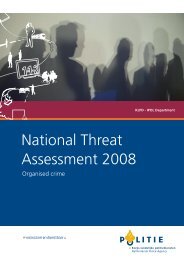Assessing the Effectiveness of Organized Crime Control Strategies ...
Assessing the Effectiveness of Organized Crime Control Strategies ...
Assessing the Effectiveness of Organized Crime Control Strategies ...
You also want an ePaper? Increase the reach of your titles
YUMPU automatically turns print PDFs into web optimized ePapers that Google loves.
5.0 Summary and Conclusions<br />
M<br />
uch <strong>of</strong> <strong>the</strong> evidence pertaining to <strong>the</strong> efficacy <strong>of</strong> OC control strategies is descriptive and<br />
anecdotal. Studies adopting sophisticated research designs are virtually non-existent. In<br />
fact, very few studies are explicitly referred to by <strong>the</strong>ir authors as evaluative studies. The multistage<br />
process used to identify relevant research reflects <strong>the</strong> paucity <strong>of</strong> efforts, in <strong>the</strong> OC<br />
literature, assessing <strong>the</strong> implementation and impact <strong>of</strong> OC control strategies. The search for<br />
materials began with a search <strong>of</strong> several major electronic databases. The bibliographies <strong>of</strong><br />
materials identified through this search were <strong>the</strong>n scanned for additional documents that might<br />
contain some additional evidence. This process was repeated as bibliographies were once again<br />
examined to complete a third round in <strong>the</strong> search for relevant materials.<br />
Several issues stand out as impediments to arriving at generalizations regarding <strong>the</strong> effectiveness<br />
<strong>of</strong> measures to control OC. A definitional morass exists, as both scholarly and legal definitions<br />
vary substantially in <strong>the</strong>ir scope. Some definitions emphasize <strong>the</strong> enterprise aspect <strong>of</strong> OC, while<br />
o<strong>the</strong>rs relate to activities frequently attributed to criminal organizations. Ano<strong>the</strong>r impediment to<br />
research and evaluation in this area is <strong>the</strong> fact that not one country routinely collects and<br />
publishes data on OC activity, however it is defined. Finally, a variety <strong>of</strong> measures have been<br />
used to gauge OC control efforts, hindering <strong>the</strong> ability to draw overall conclusions about <strong>the</strong><br />
value <strong>of</strong> <strong>the</strong>se efforts. Fur<strong>the</strong>rmore, many <strong>of</strong> <strong>the</strong>se measures have serious shortcomings.<br />
Notwithstanding <strong>the</strong>se concerns, <strong>the</strong> evidence that does exist provides some clues as to <strong>the</strong><br />
efficacy <strong>of</strong> <strong>the</strong> various approaches to controlling OC. Table 2 displays <strong>the</strong> 18 control measures<br />
or strategies that have been reviewed in this report. These measures range from regulation and<br />
legalization to tools available to prosecutors, law enforcement, and o<strong>the</strong>r public and private<br />
sector agencies.<br />
The strategies are listed in <strong>the</strong> first column <strong>of</strong> <strong>the</strong> table. The second column contains an<br />
evaluation <strong>of</strong> <strong>the</strong> volume <strong>of</strong> evidence, both quantitative and qualitative, assessing <strong>the</strong> impact <strong>of</strong><br />
each strategy or measure. The focus was on <strong>the</strong> volume ra<strong>the</strong>r than <strong>the</strong> quality <strong>of</strong> <strong>the</strong> evidence,<br />
as most <strong>of</strong> <strong>the</strong> evidence is descriptive in nature; hence <strong>the</strong>re is little variation in <strong>the</strong> quality <strong>of</strong><br />
studies. While <strong>the</strong> evaluation <strong>of</strong> <strong>the</strong> research is somewhat subjective, it is based on <strong>the</strong> evidence<br />
presented in <strong>the</strong> previous chapter. Fur<strong>the</strong>rmore, o<strong>the</strong>r scholars <strong>of</strong>ten provided <strong>the</strong>ir evaluations<br />
<strong>of</strong> <strong>the</strong> evidence in relation to <strong>the</strong> different control measures (refer to Chapter 4).<br />
Three ratings <strong>of</strong> <strong>the</strong> evidence were adopted:<br />
1. A “nil” rating was provided when <strong>the</strong>re was virtually no evidence, o<strong>the</strong>r than <strong>the</strong><br />
anecdotal, provided in relation to a measure;<br />
2. A “limited” rating meant that just a small number <strong>of</strong> studies had been undertaken and <strong>the</strong><br />
evidence was confined to just one country (usually <strong>the</strong> US);<br />
3. A “significant” rating meant that <strong>the</strong> studies were quite numerous and were found in<br />
several countries.<br />
Research and Statistics Division / Department <strong>of</strong> Justice Canada | 55








